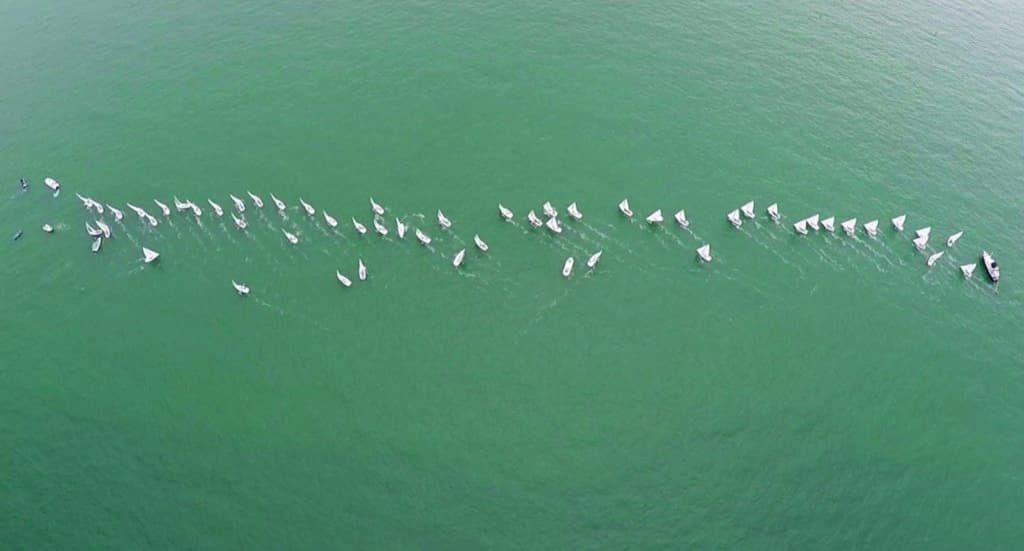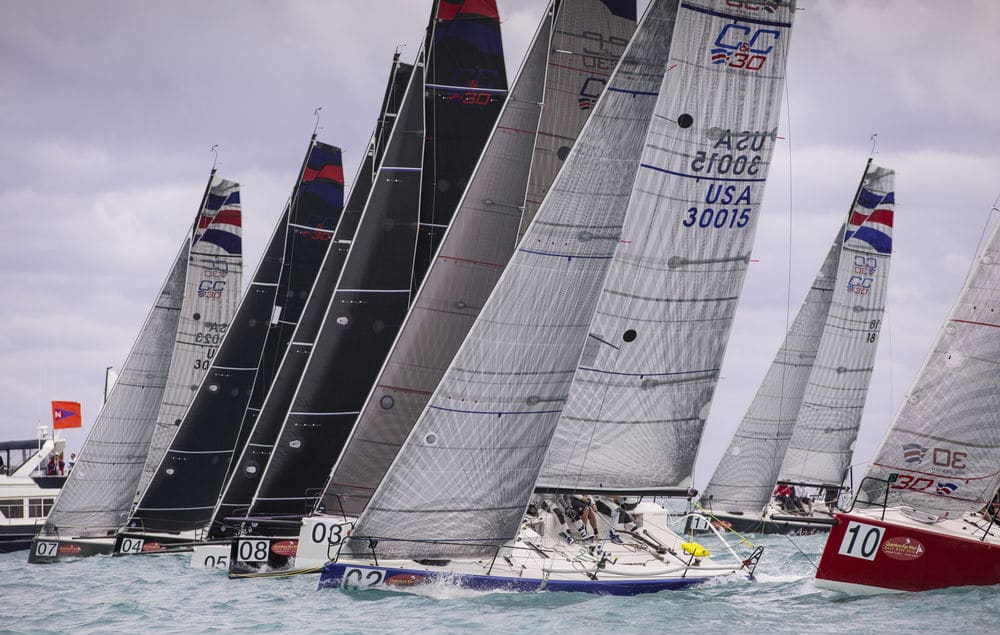
The best way to recognize an approaching windshift during the closing minutes of a prestart is to observe other boats upwind on the course, but if you’re the only class on the racecourse, or the first to start, windshift recognition starts with clues on your own boat, such as changes to your sail trim as you parallel the line, a jib that suddenly luffs, or a different angle on your final approach to the line. Observing shifts on boats up the course is best because it gives you time to react, whereas signs on your own boat mean you’re already experiencing the new wind, giving you less time to execute a change of plan. Either way, if you have time left in the sequence, you can capitalize on the shift. The key is quick reaction.
A perfect example of this once happened to me at a Melges 24 regatta. There were 54 boats on the starting line, and we were near the middle of the line; the committee boat was heavily favored. Everyone was stacked up near the committee boat, so our plan was to start to the left of the group and sail fast with a good lane. As we were waiting on starboard with one minute to go, the jib went from luffing over the port side of the bow to luffing directly in the middle, slapping against the mast.
“Are we head-to-wind?” I asked.
“Yes, I think we are!” the skipper answered.
It was a huge left shift, and my first thoughts were, “Is this real? Will it hold? Can we be this lucky?”
Our original plan had been conservative, but we called an audible and went big, given that we were just handed a great new set of circumstances: the entire fleet bunched to our right, half the long starting line wide open, and now a huge pin favor. We bore away and sailed as fast as possible toward the pin. Our timing was perfect, and we tacked at the pin, right at the gun. The left shift held, and we crossed most of the fleet by more than 50 meters.
Sure, we were lucky to be to leeward of the pack and able to take advantage of the shift, but it was an unforgettable lesson in how important it is to closely watch your sails and their attitude toward the wind, essentially using them as big tell tales.
Of course, we’re not always so lucky. At a different event we were setting up to win the pin, which was favored, and while sailing by the pin on port tack our sails were pretty eased (confirming it was pin-end favored). Our sails started luffing—right shift. We had to trim them in all the way, and now we were sailing upwind as we paralleled the line. In that moment we went from being at the upwind, favored end of the line to the downwind, unfavored end. Realizing the shift, we sailed as far as we could toward the boat end and tacked to start about one-third away from the pin, minimizing the damage.

These two scenarios highlight the importance of paying attention to your sail trim before the start, but let’s revisit what you can learn by watching other boats upwind on the course. A fleet that starts ahead are literally “tell tales” spread out across the course giving you wind directions. If you see a boat that’s bow up on starboard, they’re likely in a right shift. If they’re bow up on port, they’re probably in a left shift. If you see the leaders of a fleet ahead jibe setting around the weather mark, you can bet they’re in a right shift at the top of the course.
Also, if you think the pin is favored and you see someone sail upwind off the committee boat end (as a practice run) the angle at which they’re sailing can tell you if you’re right. For example, if their bow is up big time, they are in a right shift, and the boat is favored. If they are aiming toward the pin, they’re in a left shift, and the pin is favored. If they are sailing 45 degrees off the line, the line is square.
My rule of thumb is that, if boats are sailing roughly 45 degrees off the line as they sail upwind, the line is square, and I should start based on my upwind plan: to the left of center if I like the left, or to the right of center if I like the right. If boats are bow up, the boat is favored, and I will gravitate toward the right side of the line. If boats are bow down as they sail closehauled, I will hedge toward the pin. If you see someone sailing upwind, and their angle is different than the angles you’ve been seeing, there’s a last-minute shift, and you may need to change your plan.
The shiftier the venue the more likely you’ll see a last-minute shift. This happens often on small lakes, or in offshore winds when the course location is close to land. In these scenarios it can be safe to start near the middle of the line. With the mid-line start you’re not fully out of the race if a shift happens either direction. You may not win the race, but you’ll spare yourself a trip to the basement. When starting in the middle, if you find yourself lifted off the line, sail fast until you get headed (no need to pinch). If you come off the line severely headed in a lefty, try to tack to port as soon as possible.









